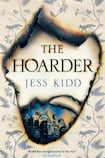
One of the many horrors that the world of reality television has given us is an insight into the disturbing world of the hoarder, those psychologically damaged souls constitutionally incapable of getting rid of anything, turning their homes into dumpsites, every room packed with rubbish, a living, breathing, stinking catalogue of their entire existence. EL Doctorow wrote a fine novel on the subject, Homer & Langley, that examined the lives of a pair of real-life brothers who amassed almost 150 tons of bric-a-brac in their New York home and, more recently, Liane Moriarty wrote of the effects on the adult offspring of hoarders in Truly Madly Guilty. The TV shows might aim low, encouraging their viewers to mock, but these novels offer a more compassionate and psychological insight into a disturbing illness.
The Irish writer, Jess Kidd, follows up her excellent debut Himself with a study of this phenomenon, opening with a carer, Maud Drennan, who is charged with helping to clear the home of an elderly man, Cathal Flood, whose house is bursting with jumble and who has already seen off more than one do-gooder who attempted to tame his living quarters.
Overwhelmed by filth
Kidd writes of the house, Bridlemere, with a claustrophobic intensity that leaves the reader, like Maud, feeling overwhelmed by the filth. There are cats everywhere, each one named after writers, and one can't help but smile at the image of Barbara Cartland intertwined with Beckett and Hemingway. Discovering a 12ft-high collection of National Geographic magazines, she writes that "each copy has been placed carefully, with aptitude and instinct, so that the whole has the arcane strength of a dry-stone wall" and the descriptions of decrepitude throughout are equally inventive.
It takes Maud a long time to work her way through Bridlemere and the writing reflects the journey, for each paragraph is dense with detail, encouraging the reader to savour every new horror.
Had the story been left to fester within the house, the novel might have proved difficult, but Kidd allows Maud some fresh air as she interacts in her own home with Renata, a landlady who shares scandalous stories from Flood’s past. It’s her belief that he was responsible for the death of his wife decades earlier and the tension that exists between Cathal and his son, Gabriel, suggests there may be some truth to the accusation. Playing amateur psychologist, she even remarks that it is grief that causes such people to be unable to part with anything, “not even a crisp packet. They can’t take another loss,” but the question lingers as to whether it might be guilt too.
Superb writing
Ironically, while the writing is superb within the confines of Bridlemere, one longs for those chapters that take place on the outside. Defying cliche, the verbal jousting between Flood and Maud is not comedic and the two characters don’t employ acerbity to mask any growing empathy. Indeed, there’s an underlying sense of violence between the pair that makes the novel a disturbing read. The unsettling tone is amplified by the mystery of a discovered photograph, featuring a little girl who no one claims to recognise and whose name has been crossed out, as well as the frequent appearances of saints, who follow Maud around in her imagination, commenting on the action and suggesting that her internal life is as chaotic as the house in which she works.
Readers of Himself will notice parallels between the two books and one can't help but wonder whether this is by chance or design. Photographs, for example, play a crucial part in both novels, Bridlemere feels like a worthy successor to Rathmore House, and Renata instantly recalls Mrs Cauley, the doyenne of Rathmore, one of the more memorable characters in the earlier book.
Truthfully, this is a difficult novel to love as the degree of melancholy that hovers over every page can leave one longing for a quick shot of Prozac, while the claustrophobia, although intentionally unnerving, occasionally runs the risk of overwhelming the story. However, Kidd writes brilliantly, her skill with language and particularly with atmosphere recalling some of the great 19th-century writers of ghost stories, a genre in which I suspect Kidd would excel should she choose to turn her hand to it. Ultimately, a rather impressive second novel, whose imaginative prowess marks its author as one to watch.
John Boyne's latest novel is The Heart's Invisible Furies









